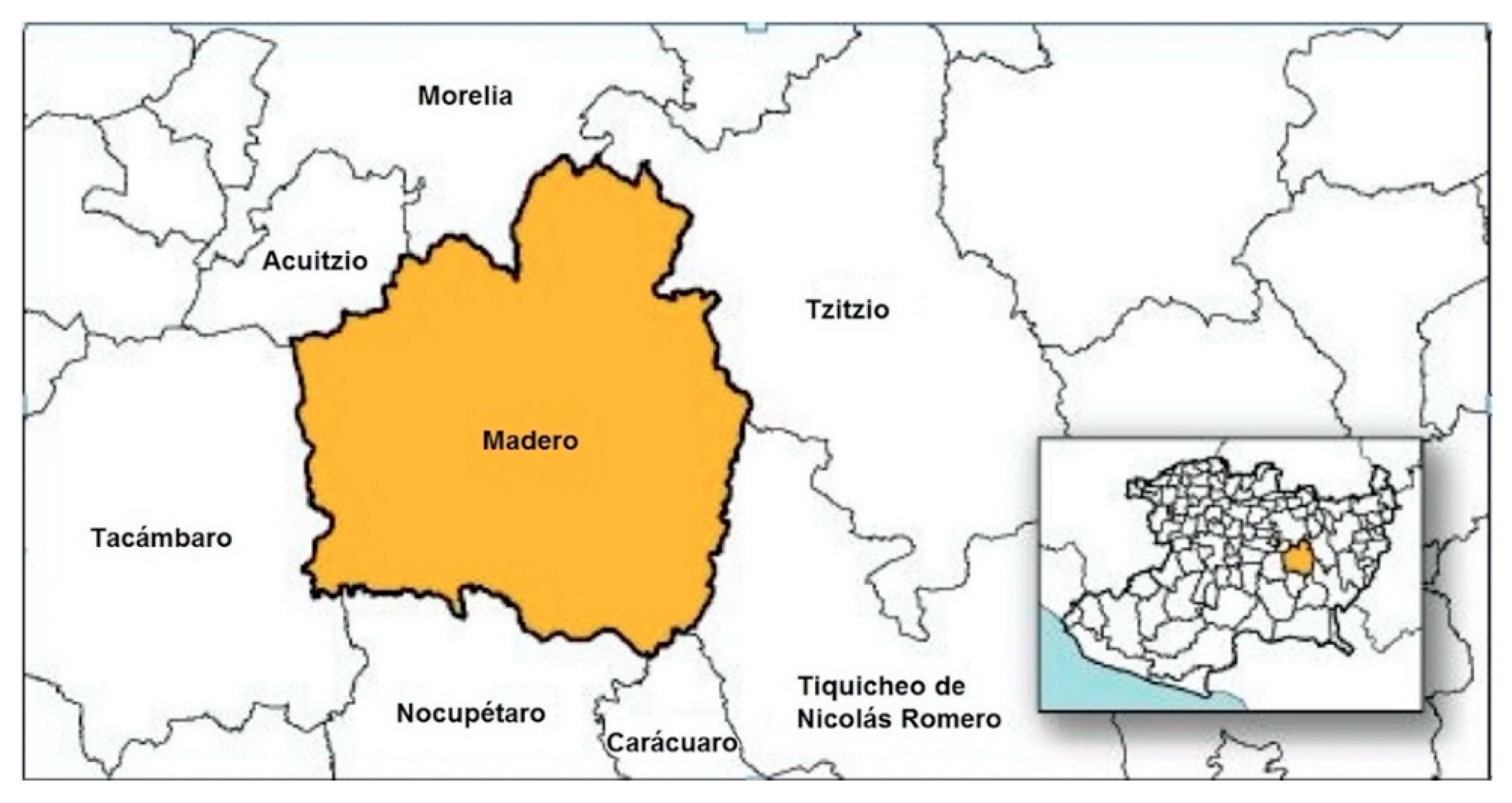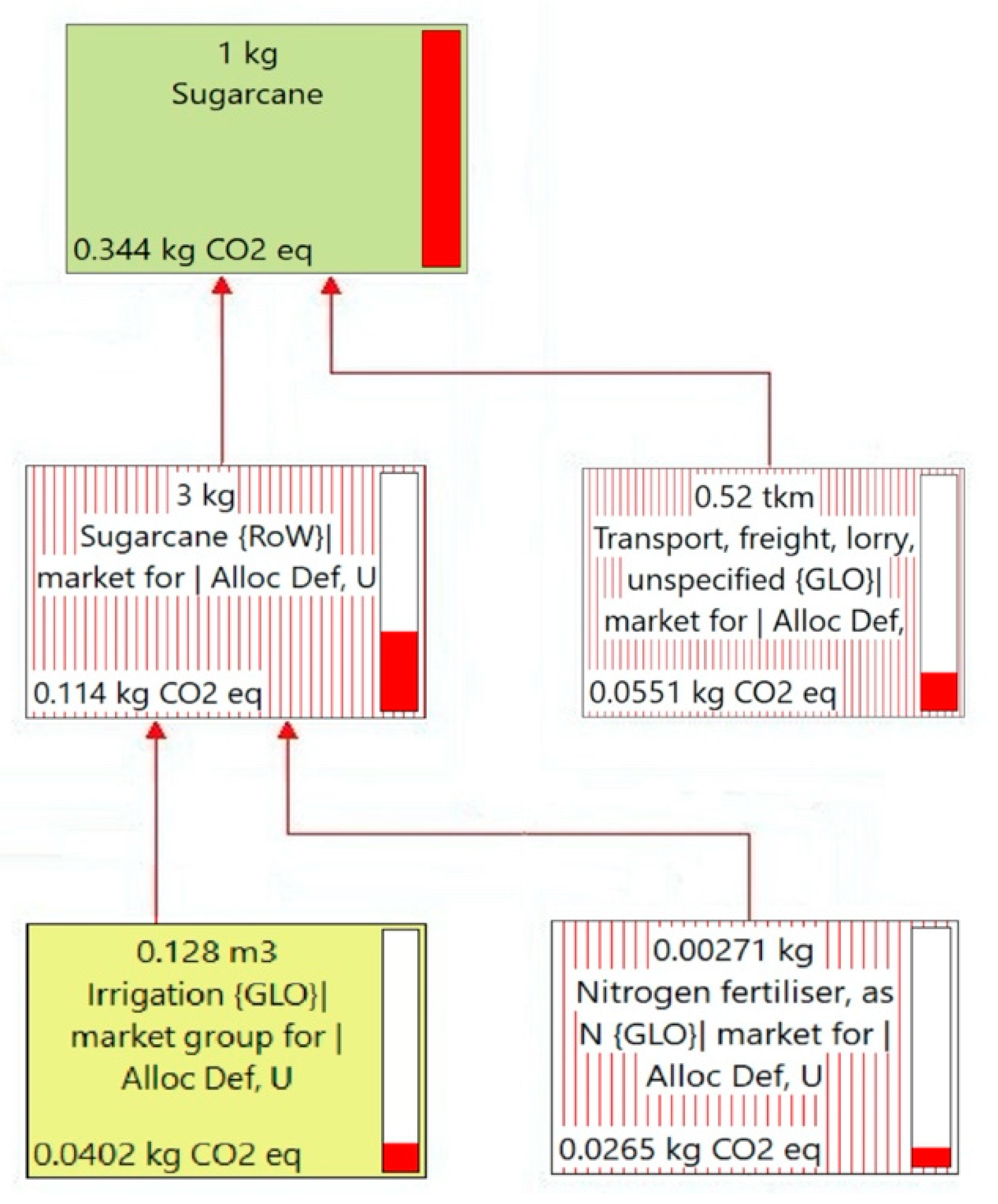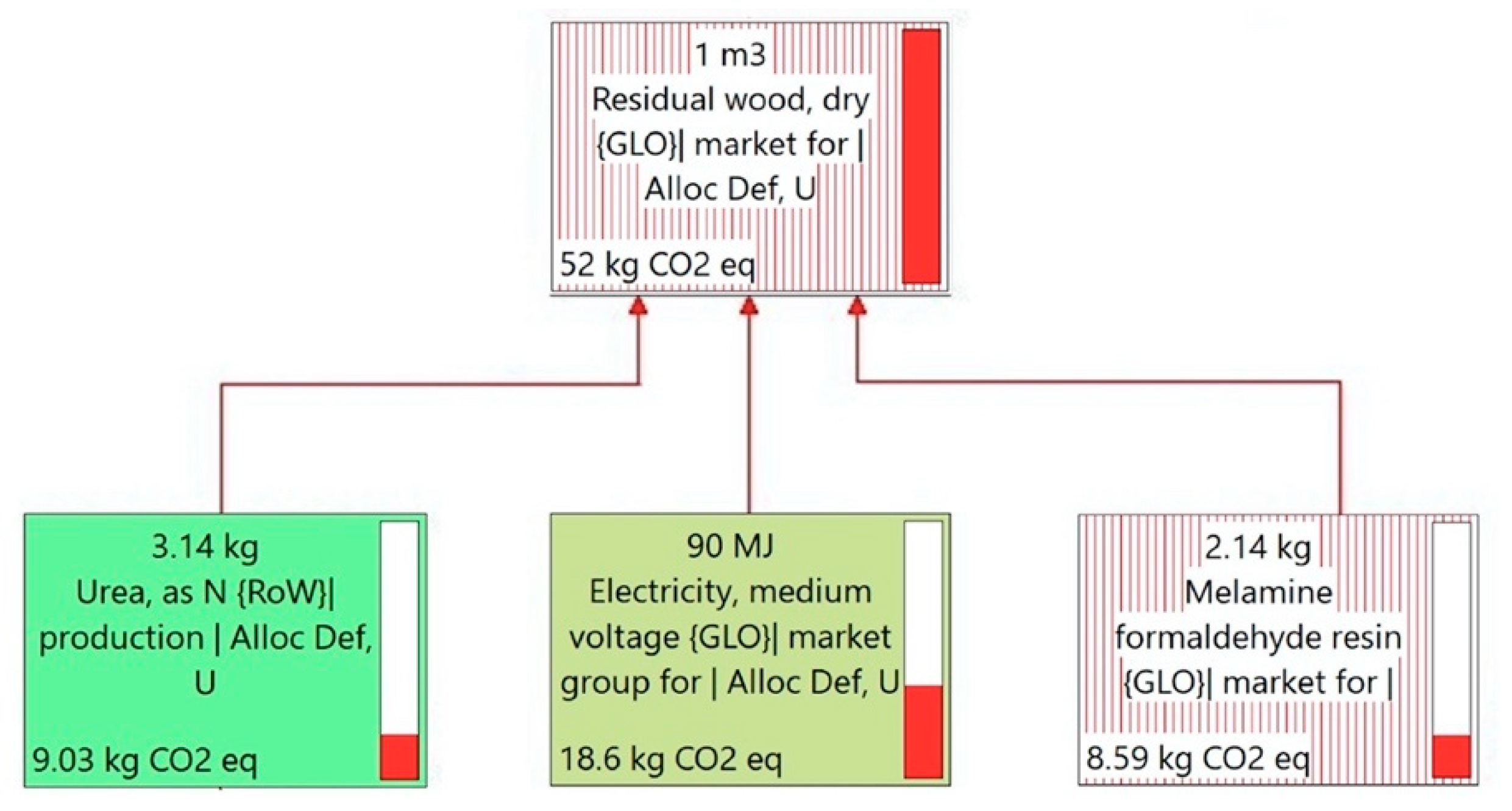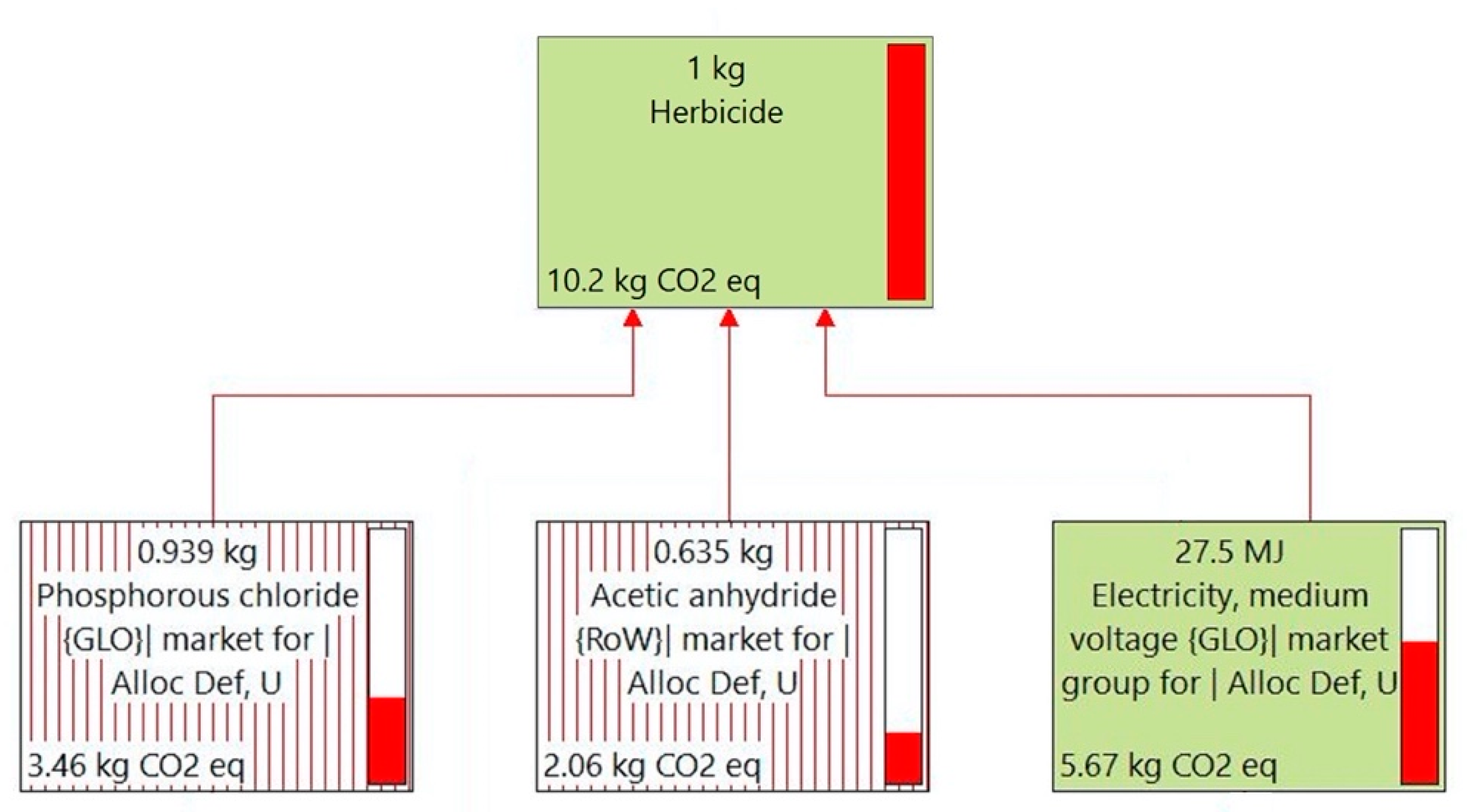Life Cycle Environmental Impacts and Energy Demand of Craft Mezcal in Mexico
Abstract
:1. Introduction
2. Materials and Methods
2.1. Study Zone
2.2. Definition of the Scope and Objectives of the Craft Mezcal Life Cycle
2.2.1. Goal
2.2.2. Scope
2.3. Types of Mezcal Considering in the Study
2.4. Life Cycle Inventory Analysis
2.5. Energy Demand of Craft Mezcal Production
3. Results and Discussion
3.1. Environmental Impact Assessment of Craft Mezcal Production
3.2. Interpreting the Potential Impact of Craft Mezcal Production
3.3. Energy Demand for Craft Mezcal Production
4. Conclusions
5. Recommendations
- Carry out a study in other vinatas or palenques of the equivalent category of mezcal to compare in other regions the critical points of environmental impact.
- Compare production processes with alternatives that may have less impact, for example, the use of renewable energies, organic agriculture, recycling, or waste management.
- Establish a guide of good environmental practices for craft mezcal production.
Author Contributions
Funding
Conflicts of Interest
References
- Consejo Regulador Mezcal. Informe Estadístico 2020; Consejo Regulador Mezcal: Oaxaca, Mexico, 2020. [Google Scholar]
- Kirchmayr, M.R.; Segura-García, L.E.; Lappe-Oliveras, P.; Moreno-Terrazas, R.; de la Rosa, M.; Gschaedler Mathis, A. Impact of environmental conditions and process modifications on microbial diversity, fermentation efficiency and chemical profile during the fermentation of Mezcal in Oaxaca. LWT Food Sci. Technol. 2017, 79, 160–169. [Google Scholar] [CrossRef]
- STID (Former Secretariat of Trade and Industrial Development). NOM-070-SCFI-2016. Norma Oficial Mexicana. Bebidas Alcohólicas-Mezcal-Especificaciones; STID: Mexico City, Mexico, 2016; (In Spanish). Available online: https://dof.gob.mx/nota_detalle.php?codigo=5472787&fecha=23/02/2017 (accessed on 14 May 2020).
- Martínez-Jiménez, R.; Ruiz-Vega, J.; Caballero-Caballero, M.; Silva Rivera, M.E.; Montes Bernabé, J.L. Wild and cultivated agaves used in the elaboration of mescal in Sola de Vega, Oaxaca, México. Trop. Subtrop. Agroecosystems 2019, 22, 477–485. [Google Scholar]
- Bautista, J.A.; Antonio-Jose, A.A.; León-Nuñez, M.J. Socioeconomic and environmental effects of overproduction of maguey mezcalero in the mezcal region of Oaxaca, México. Agric. Soc. Desarro. 2017, 14, 635–655. [Google Scholar]
- Cea Barcia, G.E.; Imperial Cervantes, R.A.; Torres Zuniga, I.; Van Den Hende, S. Converting tequila vinasse diluted with tequila process water into microalgae-yeast flocs and dischargeable effluent. Bioresour. Technol. 2020, 300, 122644. [Google Scholar] [CrossRef] [PubMed]
- Chairez-Aquino, J.; Enríquez-del-Valle, J.R.; Ruíz-Luna, J.; Campos-Ángeles, G.V.; Martínez-García, R. Uso del bagazo de Agave spp y hoja de maíz para cultivar el hongo Pleurotus ostreatus. Rev. Mex. Agroecosistemas 2015, 2, 23–28. [Google Scholar]
- Rodriguez Arreola, A.; Sanchez Tizapa, M.; Zurita, F.; Morán-Lázaro, J.P.; Castañeda Valderrama, R.; Rodríguez-López, J.L.; Carreon-Alvarez, A. Treatment of tequila vinasse and elimination of phenol by coagulation–flocculation process coupled with heterogeneous photocatalysis using titanium dioxide nanoparticles. Environ. Technol. 2020, 41, 1023–1033. [Google Scholar] [CrossRef]
- Moran-Salazar, R.G.; Sanchez-Lizarraga, A.L.; Rodriguez-Campos, J.; Davila-Vazquez, G.; Marino-Marmolejo, E.N.; Dendooven, L.; Contreras-Ramos, S.M. Utilization of vinasses as soil amendment: Consequences and perspectives. SpringerPlus 2016, 5, 1007. [Google Scholar] [CrossRef] [Green Version]
- Martínez Palacios, A.; Chávez Mendoza, S.; Reyes González, R.; Lobit, P.; Sánchez Vargas, N.; Prat, C. Manejo Forestal Para El Cultivo De Agave Cupreata; CIIDIR Unidad Oaxaca: Oaxaca, Mexico, 2017; p. 38. [Google Scholar]
- Torres-García, I.; Rendón-Sandoval, F.J.; Blancas, J.; Moreno-Calles, A.I. The genus Agave in agroforestry systems of Mexico. Bot. Sci. 2019, 97, 263–290. [Google Scholar] [CrossRef] [Green Version]
- Huerta-Zavala, J.; Sabino-López, J.E.; Ochoa-Miranda, R.; Damián-Nava, A.; Segura-Pacheco, H.R.; Hernández Castro, E. Áreas potenciales para plantaciones de Agave angustifolia Haw en Guerrero, Mexico. Agro Product. 2019, 12, 3–9. [Google Scholar] [CrossRef]
- Rangel-Landa, S.; Casas, A.; Dávila, P. Facilitation of Agave potatorum: An ecological approach for assisted population recovery. For. Ecol. Manag. 2015, 347, 57–74. [Google Scholar] [CrossRef]
- Olivera, A.A.; Caballero Caballero, M.; Alavéz Ramírez, R.; Chiñas Castillo, F.; Montes Bernabé, J.L.; Silva Rivera, M.E. Biocomposite tepexil cement reinforced with fibers of Agave angustifolia Haw. as a light mortar. Rev. Mex. Cienc. Agríc. 2018, 9, 4406–4415. [Google Scholar] [CrossRef] [Green Version]
- Montiel Corona, V.; Razo-Flores, E. Continuous hydrogen and methane production from Agave tequilana bagasse hydrolysate by sequential process to maximize energy recovery efficiency. Bioresour. Technol. 2018, 249, 334–341. [Google Scholar] [CrossRef] [PubMed]
- Caballero-Caballero, M.; Chinas-Castillo, F.; Montes Bernabé, J.L.; Alavéz-Ramirez, R.; Silva Rivera, M.E. Effect on compressive and flexural strength of agave fiber reinforced adobes. J. Nat. Fibers 2018, 15, 575–585. [Google Scholar] [CrossRef]
- Amienyo, D.; Azapagic, A. Life cycle environmental impacts and costs of beer production and consumption in the UK. Int. J. Life Cycle Assess. 2016, 21, 492–509. [Google Scholar] [CrossRef] [Green Version]
- Amienyo, D.; Camilleri, C.; Azapagic, A. Environmental impacts of consumption of Australian red wine in the UK. J. Clean. Prod. 2014, 72, 110–119. [Google Scholar] [CrossRef]
- Vázquez-Rowe, I.; Villanueva-Rey, P.; Moreira, M.T.; Feijoo, G. Environmental analysis of Ribeiro wine from a timeline perspective: Harvest year matters when reporting environmental impacts. J. Environ. Manage. 2012, 98, 73–83. [Google Scholar] [CrossRef]
- Gazulla, C.; Raugei, M.; Fullana-i-Palmer, P. Taking a life cycle look at crianza wine production in Spain: Where are the bottlenecks? Int. J. Life Cycle Assess. 2010, 15, 330–337. [Google Scholar] [CrossRef]
- Eriksson, O.; Jonsson, D.; Hillman, K. Life cycle assessment of Swedish single malt whisky. J. Clean. Prod. 2016, 112, 229–237. [Google Scholar] [CrossRef]
- Vázquez-Rowe, I.; Cáceres, A.L.; Torres-García, J.R.; Quispe, I.; Kahhat, R. Life Cycle Assessment of the production of pisco in Peru. J. Clean. Prod. 2017, 142, 4369–4383. [Google Scholar] [CrossRef]
- Meneses, M.; Torres, C.M.; Castells, F. Sensitivity analysis in a life cycle assessment of an aged red wine production from Catalonia, Spain. Sci. Total Environ. 2016, 562, 571–579. [Google Scholar] [CrossRef]
- Fusi, A.; Guidetti, R.; Benedetto, G. Delving into the environmental aspect of a Sardinian white wine: From partial to total life cycle assessment. Sci. Total Environ. 2014, 472, 989–1000. [Google Scholar] [CrossRef] [PubMed] [Green Version]
- Pimentel, D. Handbook of Energy Utilization in Agriculture; Taylor & Francis Group: Boca Raton FL, USA, 2017; ISBN 978-1-315-89341-9. [Google Scholar]
- Olajire, A.A. The brewing industry and environmental challenges. J. Clean. Prod. 2020, 256, 102817. [Google Scholar] [CrossRef]
- NISG, National Institute of Statistics and Geography. Prontuario de Información Geográfica Municipal de los Estados Unidos Mexicanos. Madero, Michoacán de Ocampo. Available online: http://www3.inegi.org.mx/contenidos/app/mexicocifras/datos_geograficos/16/16049.pdf (accessed on 7 May 2020).
- SEDESOL Census of Population and Housing. Microdata of the Sample. Madero, Michoacán de Ocampo. Geostatistical Code 16049. (In Spanish). Available online: http://www.microrregiones.gob.mx/zap/Economia.aspx?entra=nacion&ent=16&mun=049 (accessed on 8 April 2020).
- NISG, National Institute of Statistics and Geography. Mexico in Numbers. Madero, Michoacán de Ocampo. Geostatistical Code 16049. (In Spanish). Available online: https://www.inegi.org.mx/app/areasgeograficas/?ag=16 (accessed on 8 May 2020).
- Avendaño-Arrazate, C.; Iracheta-Donjuan, L.; Gódinez-Aguilar, J.; López-Gómez, P.; Barrios-Ayala, A. Morphological characterization of endemic Agave cupreata species of Mexico. Int. J. Exp. Bot. 2015, 84, 148–162. [Google Scholar]
- STID (Former Secretariat of Trade and Industrial Development). NOM-070-SCFI-1994. Norma Oficial Mexicana. Bebidas Alcohólicas-Mezcal-Especificaciones; STID: Mexico City, Mexico, 1994. (In Spanish) [Google Scholar]
- Maldonado-Rivas, P.; Pérez-Balan, R.; Aké-Canche, B.; Mex-Álvarez, R. Identificación de los Residuos sólidos urbanos con mayor reciclaje en la ciudad de San Francisco de Campeche, México. Rev. Energ. Renov. 2017, 1, 31–41. [Google Scholar]
- Mandal, K.G.; Saha, K.P.; Ghosh, P.K.; Hati, K.M.; Bandyopadhyay, K.K. Bioenergy and economic analysis of soybean-based crop production systems in central India. Biomass Bioenergy 2002, 23, 337–345. [Google Scholar] [CrossRef]
- Rivera, J.E.; Chará, J.; Barahona, R. Análisis del ciclo de vida para la producción de leche bovina en un sistema silvopastoril intensivo y un sistema convencional en Colombia. Trop. Subtrop. Agroecosystems 2016, 19, 237–251. [Google Scholar]
- Audsley, E.; European Commission. Directorate-General for Agriculture Harmonisation of Environmental Life Cycle Assessment for Agriculture: Final Report, Concerted Action AIR3-CT94-2028; CE DG VI-Centre de Documentation: Brussels, Belgium, 1997. [Google Scholar]
- Gündoğmuş, E. Energy use on organic farming: A comparative analysis on organic versus conventional apricot production on small holdings in Turkey. Energy Convers. Manag. 2006, 47, 3351–3359. [Google Scholar] [CrossRef]
- Yilmaz, I.; Akcaoz, H.; Ozkan, B. An analysis of energy use and input costs for cotton production in Turkey. Renew. Energy 2005, 30, 145–155. [Google Scholar] [CrossRef]
- Ziaei, S.M.; Mazloumzadeh, S.M.; Jabbary, M. A comparison of energy use and productivity of wheat and barley (case study). J. Saudi Soc. Agric. Sci. 2015, 14, 19–25. [Google Scholar] [CrossRef] [Green Version]
- Mohammadi, A.; Omid, M. Economical analysis and relation between energy inputs and yield of greenhouse cucumber production in Iran. Appl. Energy 2010, 87, 191–196. [Google Scholar] [CrossRef]
- SENER (Energy Secretariat). Lista De Combustibles 2018 Que Se Considerarán Para Identificar A Los Usuarios Con Un Patrón De Alto Consumo, Así Como Los Factores Para Determinar Las Equivalencias En Términos De Barriles Equivalentes De Petróleo. (In Spanish). Available online: https://www.gob.mx/cms/uploads/attachment/file/302306/Lista_de_combustibles_2018.pdf (accessed on 15 June 2020).
- Vu, T.; LeBlanc, J.; Chou, C.C. Clarification of sugarcane juice by ultrafiltration membrane: Toward the direct production of refined cane sugar. J. Food Eng. 2020, 264, 109682. [Google Scholar] [CrossRef]
- Arandes-Esteban, J.M.; Elorriaga, J.B.; Valerio, D.L. Reciclado de residuos plásticos. Rev. Iberoam. Polímeros 2004, 5, 3. [Google Scholar]
- Tobasura, I.; Moreno, F.A.; Aya, S.; Mora, J. Productividad energética y financiera en fincas campesinas del departamento de Caldas: Tres estudios de caso. Luna Azul 2012, 101–112. [Google Scholar]
- Leivas, R.; Laso, J.; Abejón, R.; Margallo, M.; Aldaco, R. Environmental assessment of food and beverage under a NEXUS Water-Energy-Climate approach: Application to the spirit drinks. Sci. Total Environ. 2020, 720, 137576. [Google Scholar] [CrossRef] [PubMed]
- Kubule, A.; Zogla, L.; Ikaunieks, J.; Rosa, M. Highlights on energy efficiency improvements: A case of a small brewery. J. Clean. Prod. 2016, 138, 275–286. [Google Scholar] [CrossRef]
- Bukhary, S.; Batista, J.; Ahmad, S. Water -energy -carbon nexus approach for sustainable large-scale drinking water treatment operation. J. Hydrol. 2020, 587, 124953. [Google Scholar] [CrossRef]






| Obtaining Raw Material | |||
|---|---|---|---|
| Inputs from Nature | Amount per FU * | Unit | Description |
| Occupation, unspecified, natural | 4.1 × 10−6 | ha | Land |
| Water, fresh | 1.05 | m3 | Water |
| Inputs from Technosphere | Amount per FU * | Unit | Description |
| Grass seed, organic, for sowing {RoW}|production|Alloc Def, U | 2 × 10−3 | kg | Seeds |
| Ammonium sulphate, as N {RoW}|ammonium sulphate production |Alloc Def, U | 3 × 10−3 | kg | Fertiliser |
| Glyphosate {RoW}|production|Alloc Def, U | 7 × 10−2 | kg | Herbicide |
| Pesticide, unspecified {RoW}|production|Alloc Def, U | 7.8 × 10−3 | kg | Insecticide |
| Transport, freight, lorry 3.5–7.5 metric ton, EURO3 {GLO}|market for|Alloc Def, U | 5.68 × 10−2 | t/km | Transport |
| Electricity, low voltage {CZ}|electricity voltage transformation from medium to low voltage|Alloc Def, U | 2.2 × 10−3 | kWh | Energy |
| Final Waste Flow | Amount per FU * | Unit | Description |
| Packaging waste, plastic | 1.62 × 10−2 | kg | Plastic bottles |
| Waste, organic | 3 × 10−3 | t | Agave leaves |
| Manufacturing/Processing | |||
| Inputs from Nature | Amount per FU * | Unit | Description |
| Water, river, MX | 2.54 × 10−2 | m3 | Water |
| Inputs from Technosphere | Amount per FU * | Unit | Description |
| Forest residue, processed and loaded, at landing system/ton/RNA | 2.4 × 10−3 | t | Firewood |
| Diesel, burned in building machine {GLO}|market for|Alloc Def, U | 13.26 × 10−2 | MJ | Energy |
| Electricity, low voltage {MX}|electricity voltage transformation from medium to low voltage|Alloc Def, U | 6 × 10−3 | kWh | Electricity |
| Transport, freight, lorry 3.5–7.5 metric ton, EURO3 {RER}|transport, freight, lorry 3.5–7.5 metric ton, EURO3|Alloc Def, U | 14.65 × 10−2 | t/km | Transport |
| Sugar, from sugarcane {GLO}| market for|Alloc Def, U | 1 × 10−3 | t | Sugar |
| Residual wood, dry {GLO}| market for|Alloc Def, U | 5 × 10−3 | t | Wood |
| Final Waste Flow | Amount per FU * | Unit | Description |
| Wood ashes | 1 × 10−4 | t | Ashes |
| Wastewater/m3 | 1.65 × 10−2 | m3 | Residual water |
| Packaging waste, plastic | 5.96 × 10−6 | kg | Plastic bottles |
| Waste, organic | 11 × 10−3 | t | Vinasses and bagasse |
| Blending and Distribution | |||
| Inputs from Technosphere | Amount per FU * | Unit | Description |
| Packaging glass, white {GLO}|market for|Alloc Def, U | 3 × 10−4 | t | Bottle |
| Polypropylene, granulate {GLO}|market for|Alloc Def, U | 2.65 × 10−6 | t | PP screw cap |
| Polypropylene, granulate {GLO}|market for|Alloc Def, U | 5.96 × 10−7 | t | Paper tag |
| Corrugated board boxes, technology mix, prod. mix, 16.6% primary fibre, 83.4% recycled fibre EU-25 S | 2.45 × 10−5 | t | Cardboard box |
| Transport, freight, lorry 3.5–7.5 metric ton, EURO3 {GLO}|market for|Alloc Def, U | 4.73 × 10−2 | t/km | Transport |
| End of Life | |||
| Inputs from Technosphere | Amount per FU * | Unit | Description |
| Packaging glass, white {GLO}|market for|Alloc Def, U | 3 × 10−4 | t | Bottle |
| Polypropylene, granulate {GLO}|market for|Alloc Def, U | 2.65 × 10−6 | t | PP screw cap |
| Printed paper {GLO}|market for|Alloc Def, U | 5.96 × 10−7 | t | Paper tag |
| Corrugated board boxes, technology mix, prod. mix, 16.6 % primary fibre, 83.4 % recycled fibre EU-25 S | 2.45 × 10−5 | t | Carton box |
| Final Waste Flow | Amount per FU * | Unit | Description |
| Wastewater/m3 | 1.643 × 10−2 | m3 | Residual water |
| Waste, organic | 1.458 × 10−2 | t | Organic waste |
| Wood ashes | 1 × 10−4 | t | Ashes |
| Packaging waste, plastic | 1 × 10−5 | kg | Plastic bottles |
| Obtaining Raw Materials | |||
| Inputs | Unit | Energy Equivalence (MJ/Unit *) | References |
| Adult agave | kg | 8.11 | This report |
| Human work | h | 1.96 | Mandal et al. [33] |
| Chainsaw | h | 4.3 | Technical data sheet |
| Gasoline transport | kg | 32.4 | Rivera et al. [34] |
| Chemicals | |||
| Fertiliser (ammonium sulphate CAS: 7783-20-2) | kg | 45 | Audesley et al. [35] |
| Herbicide (rival CAS number: 1071-83-6) | kg | 238 | Gündogmus [36] |
| Pesticide (cypermethrin CAS number: 52315-07-8) | kg | 199 | Gündogmus [36] |
| Water | m3 | 0.63 | Yilmaz et al. [37] |
| Barley seeds | kg | 14.7 | Ziaei et al. [38] |
| Manufacturing/Processing | |||
| Inputs | Unit | Energy Equivalence (MJ/Unit *) | References |
| Agave hearts | piece | 4.31 | This report |
| Human work | h | 1.96 | Mandal et al. [33] |
| Tractor/mechanical mills | MJ | 185.4 | Technical data sheet |
| Gasoline transport | kg | 32.4 | Ecoinvent 2010 from Rivera et al. [34] |
| Diesel transport | L | 56.31 | Mohammadi and Omid [39] |
| Electric power | kWh | 3.6 | |
| Firewood and wood | t | 14486 | SENER [40] |
| Water | m3 | 0.63 | Yilmaz et al. [37] |
| Sugar | t | 3083.3 | Vu et al. [41] |
| Blending | |||
| Inputs | Unit | Energy Equivalence (MJ/Unit *) | References |
| Bottles | bottles | 8.5 | Gazulla et al. [20] |
| PP screw cap | kg | 44 | Arandes-Esteban et al. [42] |
| Paper tag | t | 16.5 | SENER [40] |
| Cardboard box | t | 14.5 | SENER [40] |
| Production Stage | Mezcal Category | ||
|---|---|---|---|
| Craft Mezcal Type II * | Craft Mezcal ** | Ancestral Mezcal ** | |
| Percentages (%) | |||
Obtaining Raw Materials | 19.7 | 28.7 | 28.8 |
Manufacturing/Processing | 59.6 | 37.8 | 37.4 |
Blending and Distribution | 10.1 | 17.2 | 17.3 |
End of Life | 10.2 | 16.4 | 16.5 |
| Impact Category | Craft Mezcal Type II | Craft Mezcal | Ancestral Mezcal | |||
|---|---|---|---|---|---|---|
| RM | M | RM | M | RM | M | |
| Contribution Percentage (%) | ||||||
| Marine eutrophication | – | 90.2 | – | – | – | – |
| Photochemical oxidant formation | – | 82.2 | – | – | – | – |
| Terrestrial ecotoxicity | – | 99.2 | – | – | – | – |
| Agricultural land occupation | – | 95.4 | – | 93.9 | – | 93.9 |
| Urban land occupation | – | 86.9 | – | 85.5 | – | 85.5 |
| Natural land transformation | – | 77.8 | – | 75.0 | – | 75.0 |
| Water depletion | 86.5 | – | 99.5 | – | 99.5 | – |
| Production Stage | Mezcal Category | ||
|---|---|---|---|
| Craft Mezcal Type II | Craft Mezcal | Ancestral Mezcal | |
| Percentages (%) | |||
| Obtaining raw materials | |||
| Young agave plant | 55.8 | ||
| Adult agave | 38.8 | ||
| Agave harvest | 5.2 | ||
| Manufacturing/processing | |||
| Cooking | 2.2 | 4.4 | 4.5 |
| Milling | 0.6 | 1.7 | 0.09 |
| Fermentation | 56.3 | 3.9 | 3.9 |
| Distillation | 40.9 | 89.8 | 91.3 |
| Production Process | Fermentation with Sugar | Distillation | Young Agave Plant |
|---|---|---|---|
| Impact Category/Input | Sugarcane (96%) * | Residual Wood (94%) * | Herbicide (82%) * |
| Climate change | – | – | – |
| Ozone depletion | – | – | • |
| Terrestrial acidification | • | – | - |
| Freshwater eutrophication | • | • | • |
| Marine eutrophication | • | – | - |
| Human toxicity | • | – | • |
| Photochemical oxidant formation | • | • | – |
| Particulate matter formation | • | • | – |
| Terrestrial ecotoxicity | • | – | • |
| Freshwater ecotoxicity | • | • | • |
| Marine ecotoxicity | • | • | • |
| Ionising radiation | – | – | • |
| Agricultural land occupation | • | • | – |
| Urban land occupation | • | • | – |
| Natural land transformation | • | • | • |
| Water depletion | – | • | – |
| Metal depletion | • | • | • |
| Fossil depletion | – | – | • |
| Total significant categories | 13 | 10 | 10 |
| Impact Category/Input | Residual Wood | Propane |
|---|---|---|
| Amount of Fuel (kg) | 5 | 1.6 |
| 72.43 MJ | ||
| Climate change kg carbon dioxide-eq (CO2-eq) | – | 1631.8 |
| Terrestrial acidification kg of sulphur dioxide-eq (SO2-eq) | – | 2.8 |
| Human toxicity kg de 1,4 dichlorobenzene-eq (1,4-DB-eq) | – | 870.1 |
| Photochemical oxidant formation kg of volatile non-methane organic compounds (NMVOC) | – | 2.8 |
| Freshwater ecotoxicity kg 1,4 dichlorobenzene-eq (1,4-DB-eq) | – | 7.2 |
| Marine ecotoxicity kg 1,4 dichlorobenzene-eq (1,4-DB-eq) | – | 7.1 |
| Agricultural land occupation m2 | 6.3 | – |
| Fossil depletion kg oil-eq | – | 525.6 |
| Beverage (750 mL) | Emissions kg CO2 eq | References |
|---|---|---|
| Craft mezcal | 1.7 | This report |
| Gin | 0.62 | Leivas et al. [44] |
| Beer | 0.63 | Amienyo et al. [17] |
| Crianza wine | 0.93 | Gazulla et al. [20] |
| Aged red wine | 0.95 | Meneses et al. [23] |
| White wine | 1.01 | Fusi et al. [24] |
| Austrailian red wine | 1.25 | Amienyo et al. [18] |
| Whisky | 2.25 | Eriksson et al. [21] |
| Ribeiro wine | 2.64 | Vázquez-Rowe et al. [19] |
| Pisco | 3.62 | Vázquez-Rowe et al. [22] |
| Stage | Power Inputs (MJ/FU) | Contribution (%) |
|---|---|---|
| Obtaining raw materials (agave) | 21.4 | |
| Herbicide | 16.7 | 47.6 |
| Gasoline transport | 12.0 | 34.3 |
| Human work | 3.9 | 11.1 |
| Others ** | 2.4 | 6.9 |
| Subtotal stage | 35 | |
| Manufacturing/Processing | 73.4 | |
| Agave * | – | – |
| Firewood and wood | 107.2 | 89.1 |
| Gasoline transport | 8.0 | 6.7 |
| Sugar | 3.1 | 2.6 |
| Others ** | 2.0 | 1.6 |
| Subtotal stage | 120.3 | |
| Blending | 15.1 | |
| Bottles | 8.5 | 99.5 |
| Others ** | 0.04 | 0.5 |
| Subtotal stage | 8.5 | |
| Total | 163.8 | 100 |
| Product (7.5 dL) | SE (MJ/dL) | PE (dL/MJ) | Country | References |
|---|---|---|---|---|
| Craft mezcal Type II | 21.8 | 0.05 | Mexico | This report |
| Whisky | 7.6 | 0.13 | Sweden | Eriksson et al. [21] |
| Wine | 3.0 | 0.33 | United Kingdom | Amienyo et al. [18] |
| Gin | 1.83 | 0.55 | Spain | Leivas et al. [44] |
| Beer | 1.75 | 0.57 | United Kingdom | Amienyo et al. [17] |
| Beer | 0.3 | 3.33 | Latvia | Kubule et al. [45] |
| Beer | 0.19 | 5.18 | Nigeria | Olajire [26] |
| Drinking water | 0.02 | 48.14 | United States | Bukhary et al. [46] |
© 2020 by the authors. Licensee MDPI, Basel, Switzerland. This article is an open access article distributed under the terms and conditions of the Creative Commons Attribution (CC BY) license (http://creativecommons.org/licenses/by/4.0/).
Share and Cite
Maciel Martínez, J.; Baltierra-Trejo, E.; Taboada-González, P.; Aguilar-Virgen, Q.; Marquez-Benavides, L. Life Cycle Environmental Impacts and Energy Demand of Craft Mezcal in Mexico. Sustainability 2020, 12, 8242. https://doi.org/10.3390/su12198242
Maciel Martínez J, Baltierra-Trejo E, Taboada-González P, Aguilar-Virgen Q, Marquez-Benavides L. Life Cycle Environmental Impacts and Energy Demand of Craft Mezcal in Mexico. Sustainability. 2020; 12(19):8242. https://doi.org/10.3390/su12198242
Chicago/Turabian StyleMaciel Martínez, Jazmín, Eduardo Baltierra-Trejo, Paul Taboada-González, Quetzalli Aguilar-Virgen, and Liliana Marquez-Benavides. 2020. "Life Cycle Environmental Impacts and Energy Demand of Craft Mezcal in Mexico" Sustainability 12, no. 19: 8242. https://doi.org/10.3390/su12198242







